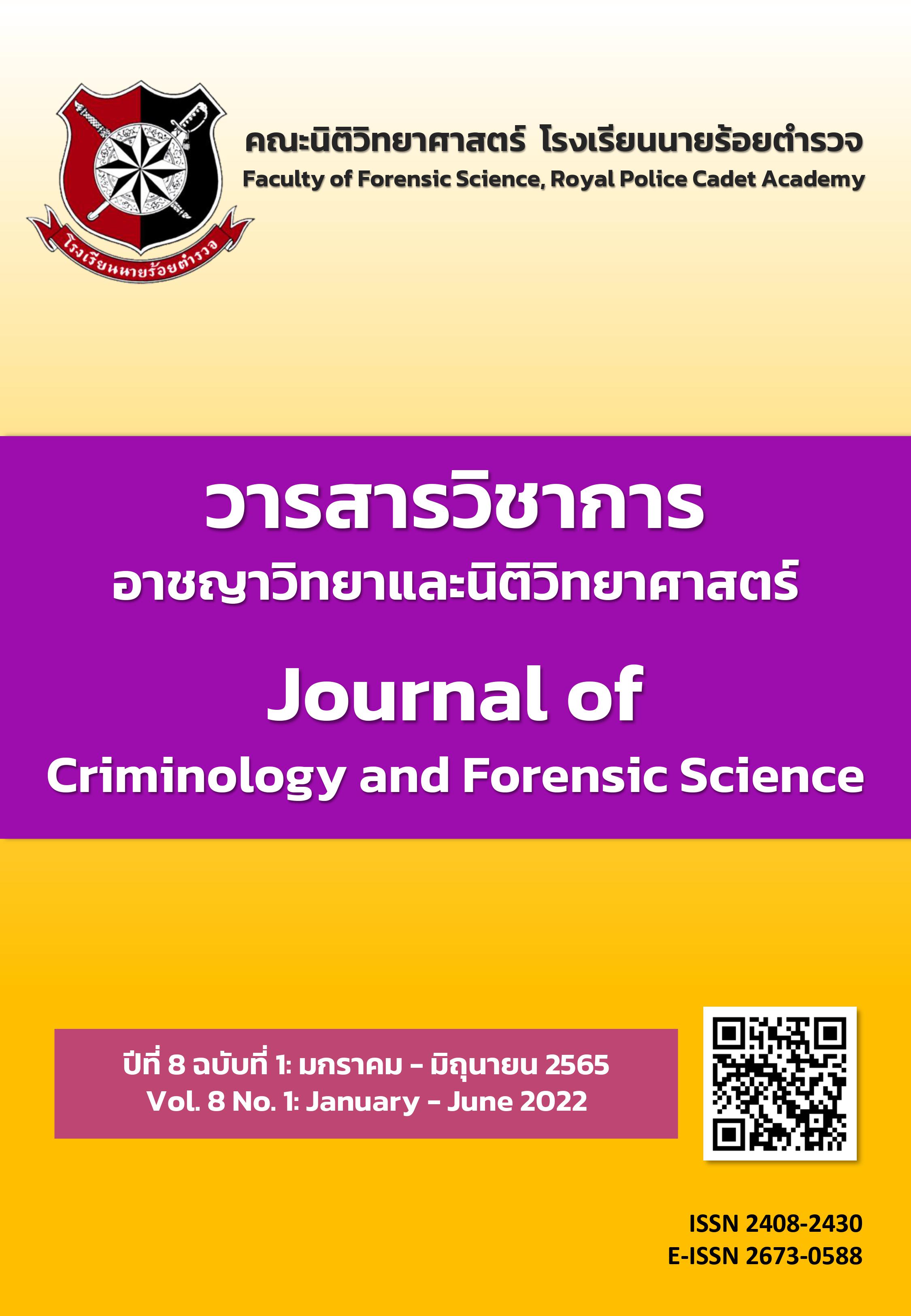การตรวจสอบคราบโลหิตของมนุษย์บนผ้าที่ผลิตจากเส้นใยธรรมชาติ เส้นใยสังเคราะห์ และเส้นใยผสมด้วยวิธีบลูสตาร์
Main Article Content
บทคัดย่อ
การวิจัยครั้งนี้มีวัตถุประสงค์ 1) เพื่อเปรียบเทียบการตรวจสอบคราบโลหิตในสภาพอากาศที่ต่างกันด้วยวิธีบลูสตาร์ 2) เพื่อเปรียบเทียบการตรวจสอบคราบโลหิตบนเสื้อผ้าต่างชนิด ได้แก่ เสื้อผ้าจากเส้นใยธรรมชาติ เสื้อผ้าจากเส้นใยสังเคราะห์และเสื้อผ้าจากเส้นใยผสม ด้วยวิธีบลูสตาร์ และ 3) เพื่อศึกษาความไวของการตรวจสอบคราบโลหิตที่ถูกทิ้งไว้ในระยะเวลาต่างกันด้วยวิธีบลูสตาร์ โดยทำการทดลองด้วยการนำโลหิตมาเจือจางด้วยน้ำกลั่นในอัตราส่วน 1:100, 1:1,000, 1:10,000 และ 1:100,000 โดยปริมาตร จากนั้นนำมาหยดลงบนตัวอย่างชิ้นงานแบ่งเป็น 2 ชุด เก็บไว้ในสภาพอากาศร้อนชื้นในประเทศไทยอุณหภูมิเฉลี่ย 30.14 ± 1.78 องศาเซลเซียส และความชื้นสัมพัทธ์เฉลี่ยเท่ากับร้อยละ 73.75 ± 6.97 และเก็บไว้ในสภาพอากาศหนาว จำลองอากาศที่อุณหภูมิเฉลี่ยเท่ากับ 7.58 ± 1.25 องศาเซลเซียส และความชื้นสัมพัทธ์เฉลี่ยเท่ากับร้อยละ 53.56 ± 5.78 และทำการตรวจคราบโลหิตที่ระยะเวลา 1, 3, 5, 7 และ 9 สัปดาห์ ตามลำดับ ด้วยวิธีบลูสตาร์ ผลการทดลองพบว่า ในสภาพอากาศหนาวสามารถตรวจพบคราบโลหิตที่เจือจางได้มากกว่าในสภาพอากาศร้อนชื้นในประเทศไทย โดยเสื้อผ้าจากเส้นใยสังเคราะห์สามารถตรวจพบคราบโลหิตที่เจือจางที่สุดได้ในอัตราส่วน 1:10,000 โดยปริมาตร เสื้อผ้าจากเส้นใยธรรมชาติและเสื้อผ้าจากเส้นใยผสมสามารถตรวจพบคราบโลหิตที่เจือจางที่สุดได้ในอัตราส่วน 1:1,000 โดยปริมาตร ในทุกระยะเวลาที่มีการหยดโลหิตทิ้งไว้ และในสภาพอากาศร้อนชื้นในประเทศไทย ที่มีอุณหภูมิไม่เกิน 40 องศาเซลเซียส พบว่าเสื้อผ้าจากเส้นใยสังเคราะห์สามารถตรวจพบคราบโลหิตที่เจือจางที่สุดได้ในอัตราส่วน 1:1,000 โดยปริมาตร ในระยะเวลาที่มีการหยดโลหิตทิ้งไว้ 1 และ 3 สัปดาห์ เสื้อผ้าจากเส้นใยธรรมชาติและเสื้อผ้าจากเส้นใยผสมสามารถตรวจพบคราบโลหิตที่เจือจางที่สุดได้ในอัตราส่วน 1:100 โดยปริมาตร ในทุกระยะเวลาที่มีการหยดโลหิตทิ้งไว้ จากผลการทดลองนี้แสดงให้เห็นว่า อุณหภูมิ, ชนิดของเส้นใย และความเข้มข้นของโลหิตที่หยดลงบนตัวอย่างชิ้นงาน ล้วนมีผลต่อการตรวจคราบโลหิตด้วยวิธีบลูสตาร์ ทั้งสิ้น และสามารถนำไปใช้ประโยชน์ในกระบวนการทางนิติวิทยาศาสตร์ได้
Article Details

This work is licensed under a Creative Commons Attribution-NonCommercial-NoDerivatives 4.0 International License.
เนื้อหาและข้อมูลในบทความที่ลงตีพิมพ์ใน วารสารวิชาการอาชญาวิทยาและนิติวิทยาศาสตร์ โรงเรียนนายร้อยตำรวจ ถิอว่าเป็นข้อคิดเห็นและความรั้บผิดชอบของผู้เขียนบทความโดยตรงซึ่งกองบรรณาธิการวารสาร ไม่จำเป็นต้องเห็นด้วยหรือรับผิดชอบใดๆ
บทความ ข้อมูล เนื้อหา รูปภาพ ฯลฯ ที่ได้รับการตีพิมพ์ใน วารสารวิชาการอาชญาวิทยาและนิติวิทยาศาสตร์ ถือว่าเป็นลิขสิทธิ์ของวารสาร วารสารวิชาการอาชญาวิทยาและนิติวิทยาศาสตร์ หากบุคคลหรือหน่วยงานใดต้องการนำทั้งหมดหรือส่วนหนึ่งส่วนใดไปเผยแพร่ต่อหรือเพื่อกระทำการใดๆ จะต้องได้รับอนุญาตเป็นลายลักษณ์อักษรจาก วารสารวิชาการอาชญาวิทยาและนิติวิทยาศาสตร์ ก่อนเท่านั้น
References
Bara Scientific Co., Ltd. (2551). Forensic Science. Retrieved May 15, 2021. From http:// www.barascientific.com/article/Forensice/forensic.php. (In Thai).
Charoonruangrit, U. & Bhakbhumpong, T. (2008). Management of Blood Cold Chain Equipment. Journal of Hematology and Transfusion Medicine. 18 (3), 235 – 241. (In Thai).
Kornthong, P., Preecharram, S. & Phutdhawong W., (2015). Comparison of Bloodstain Detection Using Kastle-Meyer, Luminol and BlueStar® Methods on Porous and Non-porous Substrates. Proceedings of the 5th STOU Graduate Research Conference, Thailand. (In Thai).
Ngamkam, P. & Mahacharoen, T. (2018). Age Estimation of Bloodstain by Using UV-Visible Spectrometer. Suan Dusit Graduate School Academic Journal. 14(2), 215-229. (In Thai).
Pansri, S. (2006). Identification of Bloodstains. Bull Chiang Mai Assoc Med Sci. 39(3), 25 – 28. (In Thai).
Prahsarn, C. (2002). Technical textile. The National Metal and Materials Technology Center (MTEC). 30 – 34. (In Thai).
Purimano, S. (2012). Detection of Blood strain by Phenolphthalein Test, Tetramethyl-benzidine Test, Luminol Test, and Blue Star Test. Master of Science Thesis Silpakorn University, Nakhon Pathom. (In Thai).
Royal Thai Police. (2020). Statistics on the base of criminal offenses (4 groups of cases) from across the country in 2020. Retrieved December 31, 2020. From http://pitc.police.go.th/dirlist/dirlist.php?dir=/crimes. (In Thai).
Somburut, W. & Saksiri, N. (2019). The Interactions among the Characteristics of Variables Involving Bloodstain Cleaning on Efficiency of Bloodstain Detection by Luminol and Bluestar Methods). PBRU Science Journal. 16(1), 55–68. (In Thai).
Yimnoon, J. (2016). Detection of Humen Bloodstains on Various Types of Shoe Soles by The Methods of Phenolphthalein, Luminol, and Fluorescein. Master of Science Thesis Silpakorn University, Nakhon Pathom. (In Thai).

